
Author: Toni Wahrstätter Source: ethresear.ch Translation: Shan Oppa, Bitchain Vision
Brief Overview:
-
The builder may have no motivation to include the blob due to higher latency caused by the blob.
-
Non-MEV-Boost users include more blobs in blocks on average than MEV-Boost builders.
-
Compared with non-MEV-Boost users, the probability of MEV-Boost users being reorganized is significantly reduced (see MEV-Boost and Reorganization sections for details).
-
Rsync-Builder and Flashbots builders have lower average blobs per block than other builders.
In recent analysis of large blocks, blobs and reorganization, the impact of blobs on reorganization probability can be seen.
In what follows, I would like to include the MEV-Boost ecosystem in consideration for further discussion.
The basic questions are:-> “Does MEV-Boost affect restructuring?If so, how big is the impact?”
Blobs are “large” objects, and large objects cause higher latency.So, the builder may not include a blob in its block under the following circumstances:
-
The builder commits blocks later in the slot to minimize delays (see timed game).
-
The builder wants to capture high MEV opportunities and does not want to invalidate its blocks due to unavailable blobs.
-
Proponents have poor connectivity (because the spread starts later).
BuilderCompensation through priority fees may be required to include transactions that may cause higher latency in block propagation.Before 4844, these transactions were mainly transactions containing a large number of calldata.Since 4844, blobs have become the main driver of latency.
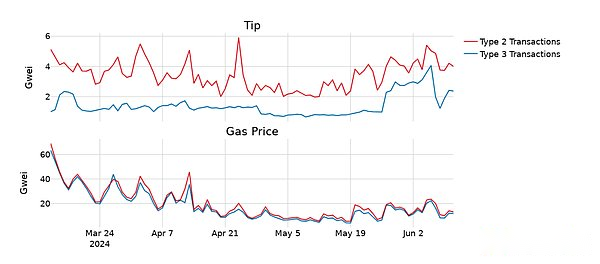
As shown in the above figure, the tips for blob transactions are not as good as regular Type-2 transactions.
Based on this, blobs will not give builders significant advantages when competing for the same time slots.Another explanation might be a private transaction between the builder and the rollup to ensure timely inclusion of blob transactions by the fees paid through the side channel.
MEV-Boost and reorganization
MThe EV-Boost ecosystem consists of complex participants, builders and repeaters, these participants are well connected and are specialized in establishing low-latency connections with peers.Therefore, proposers using MEV-Boost should be reorganized less than “Vanilla Builders” (i.e. users who do not use MEV-Boost).
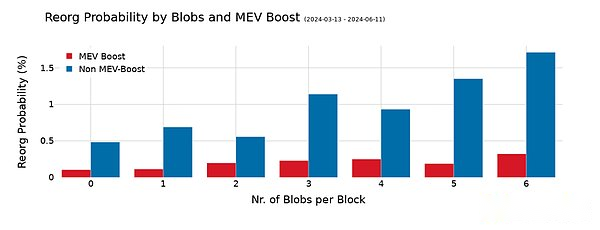
This expectation holds true when viewing the image above.We can see,As the number of blobs increases, the probability of recombination increases.However, the probability of reorganization for MEV-Boost users is much lower than that of non-MEV-Boost users (Vanilla Builders).
In this case, it is important not to confuse correlation and causality:
-> Non-MEV-Boost users are on average less complex entities, which also leads to the effects we observed in the figure above.
In this case, it is interesting to compare the average number of blobs per block for MEV-Boost users and non-MEV-Boost users.
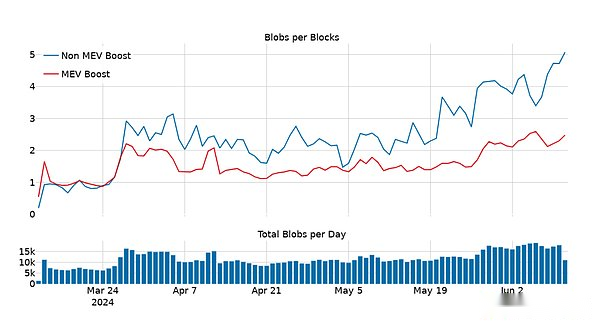 As shown in the above image, proposers who do not use MEV-Boost include more blobs in their blocks on average, while MEV-Boost users are fewer.This may indicate that MEV-Boost ecosystem participants (repeaters and builders) have adopted a strategy beyond the “inclusion if there is space”.
As shown in the above image, proposers who do not use MEV-Boost include more blobs in their blocks on average, while MEV-Boost users are fewer.This may indicate that MEV-Boost ecosystem participants (repeaters and builders) have adopted a strategy beyond the “inclusion if there is space”.
First, let’s take a closer look at the builder.
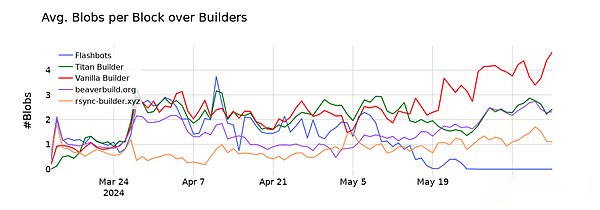
Vanilla Builders (non-MEV-Boost Proposal) have the highest blob inclusion rate, followed by Beaverbuild and Titan Builder.
Rsync-Builder seems to contain much fewer blobs in its blocks.The same applies to Flashbots builders, which seemed to change behavior in early May, with the average number of blobs per block approaching zero.
“Is it fair to say ‘builder XY review blobs’?”
Unfair
Different builders adopt different strategies.For example, builders like Rsync-Builder are often competitive in time slots with low latency and speed importance, and may end up winning blocks without blobs (see Selection Bias).
Next, let’s turn our focus to repeaters:
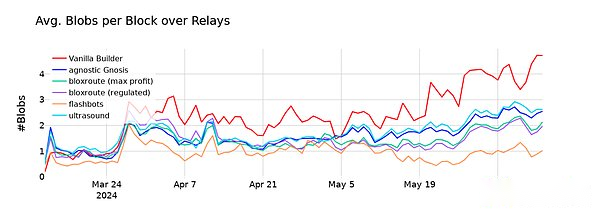 As shown above, Vanilla Builders has the highest average blob inclusion rate.Ultrasound and Agnostic Gnosis repeaters are ranked second and third respectively, followed by BloXroute’s repeaters.The Flashbots repeater seems to contain the least number of blobs.
As shown above, Vanilla Builders has the highest average blob inclusion rate.Ultrasound and Agnostic Gnosis repeaters are ranked second and third respectively, followed by BloXroute’s repeaters.The Flashbots repeater seems to contain the least number of blobs.
Importantly, repeaters rely on builders, and ultimately the builders influence the chart above.
Next step
In the context of PeerDAS 10, the network will have to rely on nodes that are more powerful than other nodes and capable of handling more than 6 blobs per block.Therefore, it will be of great value to see more research on the topic.
-
Reproduction Call: It would be great if someone could verify my results by reproducing this analysis.
-
Investigate why some builders have significantly lower blob inclusion rates than others.
-
Reduce the reorganization rate of non-MEV-Boost users: Repeaters can provide their block propagation services to non-MEV-Boost users to ensure that their blocks are less reorganized.
The blob market is still developing, and the stable blob prices have not been discovered yet.As demand for blob space increases, tips from blob transactions may catch up with regular transactions.








